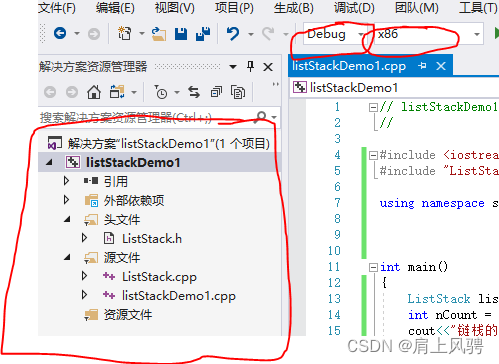什么是链栈
链栈不名思意,就是既具有链表的特性,又具有栈的特性。
即:
- 链栈中的元素由指针域和数据域组成,通过指针指向下一个元素;2.链栈同时又具有栈的特性,先进后出。
如何实现链栈
根据上述链栈所具有的特征,这里需要创建一个链表结构体和一个栈结构体。然后创建一个链栈类,通过对链表和栈的特性的应用来实现链栈。(这里只是一个思路)
链栈的实现
开发环境
作者采用的是visual studio 2017,编译的是debug版本下的x86。如下图:

创建的是控制台输出程序,创建过程这里忽略。
代码实现
共包含三个文件:listStackDemo1.cpp,ListStack.h,ListStack.cpp。其中listStackDemo1.cpp就是主函数所在的文件,相当于以往的main.cpp,其中是链栈的使用。ListStack.h和ListStack.cpp类主要实现链栈。
下面是具体代码:
ListStack.h
#pragma once
typedef struct ListNode
{
char data;
struct ListNode *pNext;
}stuNode;
typedef struct Stack
{
stuNode *pTop;
int nSize;
}stuListStack;
class ListStack
{
public:
ListStack();
bool isEmpty();
void push(char c);
char pop();
int getSizeCount();
void print();
private:
stuListStack m_listStack;
};
ListStack.cpp
#include "ListStack.h"
#include <iostream>
using namespace std;
ListStack::ListStack()
{
m_listStack.pTop = nullptr;
m_listStack.nSize = 0;
}
bool ListStack::isEmpty()
{
if (m_listStack.pTop == nullptr)
{
return true;
}
return false;
}
void ListStack::push(char c)
{
stuNode *pNode = new stuNode;
pNode->data = c;
pNode->pNext = m_listStack.pTop;
m_listStack.pTop = pNode;
m_listStack.nSize++;
}
char ListStack::pop()
{
if (isEmpty())
{
return -1;
}
char c = m_listStack.pTop->data;
stuNode *pDelete = m_listStack.pTop;
m_listStack.pTop = m_listStack.pTop->pNext;
m_listStack.nSize--;
delete pDelete;
return c;
}
int ListStack::getSizeCount()
{
return m_listStack.nSize;
}
void ListStack::print()
{
stuNode *p = m_listStack.pTop;
while (p)
{
cout << p->data << " ";
p = p->pNext;
}
cout << endl;
}
listStackDemo1.cpp
#include <iostream>
#include "ListStack.h"
using namespace std;
int main()
{
ListStack listStack;
int nCount = listStack.getSizeCount();
cout<<"链栈的元素个数:"<< nCount <<endl;
listStack.push('A');
listStack.push('B');
listStack.push('C');
listStack.push('D');
listStack.push('E');
listStack.print();
cout << "请输入出栈次数:"<<endl;
int m;
cin >> m;
for (int i = 0; i < m;++i)
{
cout<<listStack.pop()<<" ";
}
cout << endl;
nCount = listStack.getSizeCount();
cout <<"出栈后链栈中的元素个数:"<< nCount<<endl;
listStack.print();
return 0;
}
运行结果























 3545
3545











 被折叠的 条评论
为什么被折叠?
被折叠的 条评论
为什么被折叠?










